We’re excited to be named a 2023 New England Food Vision Prize winner by the Henry P. Kendall Foundation! Together with the Boston Area Gleaners / Boston Food Hub, Harvesting Good, and … Read More →
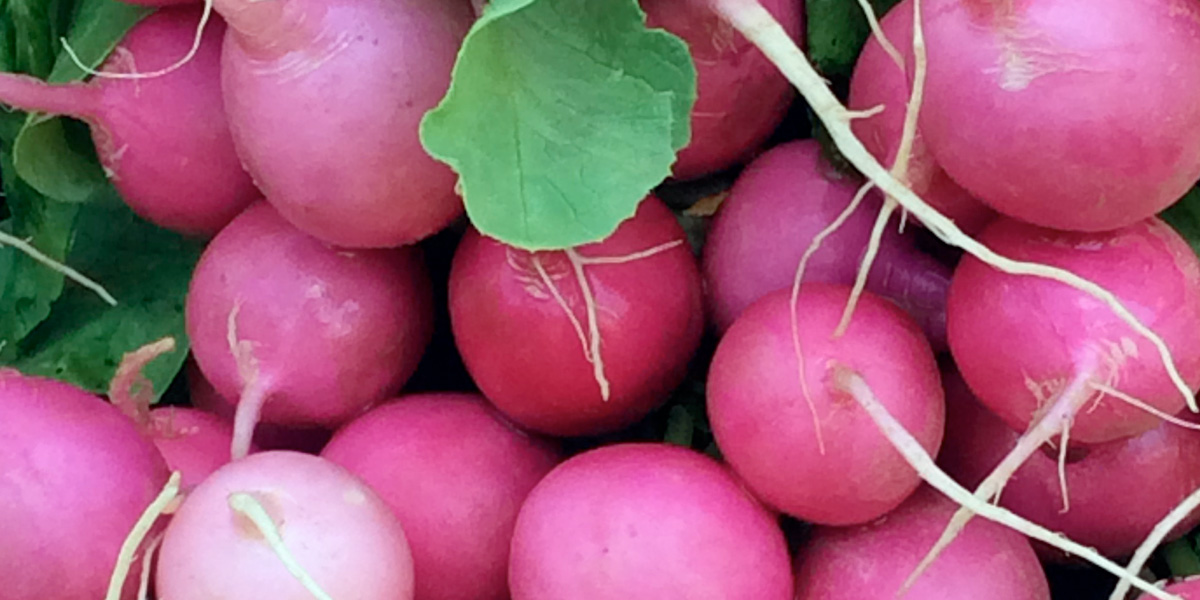
VEGGIE PROFILES
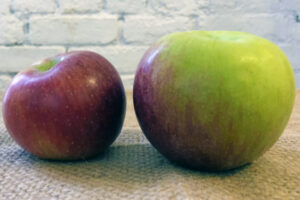 When it comes to local apples, one a day is not nearly enough! With so many different flavors, textures, consistencies, and colors there are enough kinds to please every palette. Just don’t eat the seeds.
When it comes to local apples, one a day is not nearly enough! With so many different flavors, textures, consistencies, and colors there are enough kinds to please every palette. Just don’t eat the seeds.
Storage: Apples will stay fresher longer if kept in the refrigerator. With Jersey Mac’s you don’t have a choice. Keep them in the refrigerator or else they will perish.
Preparing: Wash and dry. Slice. Eat. Keep them from going brown with this advice! Or you can cook with them by preparing them sliced with hard cheeses, peanut butter, or honey; or in sandwiches, salads, coleslaw, bread, pie, muffins, soup… in almost anything!
Preserving: Make applesauce or try drying them, or even pickling!
Delicate in appearance alone, Arugula is quite a spicy little leaf. Salad will never be boring again. If you don’t care for the sharp taste, cooking will mellow it down. There are many different varieties of arugula. If you are lucky enough to get your hands on micro-arugula you can treat it like a spicy herb! Its diminished size does not indicate diminished flavor: it contains the powerful flavor of arugula, just in smaller packaging.
Storage: Store in a plastic bag in the refrigerator for up to a few days.
Preparing: Wash and dry. Great in salads (if you don’t feel like using a recipe, just drizzle with olive oil, salt, pepper, and lemon juice), on pizza, in sandwiches, in frittatas, sautéed, with beans in pesto, and in pasta.
Preserving: If you can’t keep up with it, try freezing it.
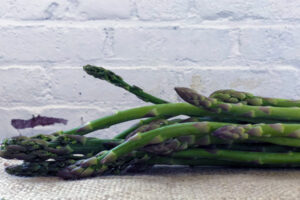 Elegant asparagus is an exquisite element of every meal in which it appears. This long and slender spring vegetable is beautiful to look at and wonderful to eat.
Elegant asparagus is an exquisite element of every meal in which it appears. This long and slender spring vegetable is beautiful to look at and wonderful to eat.
Storage: Keep in the refrigerator for up to a few days. Store asparagus like flowers in a jar, covered with a plastic bag, or keep in a plastic bag with the ends wrapped in a damp towel.
Preparing: Rinse and trim the base of the stems. Eat asparagus raw, blanched, roasted, and grilled.
Preserving: Freeze your asparagus or try making pickled asparagus!
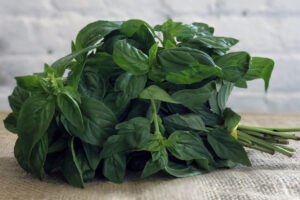 The smell of this herb could make anyone smile, and its applications are numerous. Basil appears in pesto, on pizzas, in soups, and in salads. There as many kinds of basil as there are uses (including basil tea!), so be on the lookout for different colors and kinds. Its appeal is so universal because it tastes so good. Although its flavor is powerful, treat your leaves gently!
The smell of this herb could make anyone smile, and its applications are numerous. Basil appears in pesto, on pizzas, in soups, and in salads. There as many kinds of basil as there are uses (including basil tea!), so be on the lookout for different colors and kinds. Its appeal is so universal because it tastes so good. Although its flavor is powerful, treat your leaves gently!
Storage: Storing basil can be tricky. Keep in a jar with water like flowers, but loosely covered with a plastic bag. Only wash the amount you plan on using immediately before using. Use within a few days.
Preparing: Wash basil and remove leaves. The stems are edible so sample them and see if you like them. If you do, chop them up and add them to dishes for extra flavor. The leaves can be added to anything raw or cooked. Pesto is an easy-to-make product using basil. But there also many other things you can do with basil, for example basil chips are an option for the adventurous or you can just toss some in your scrambled eggs.
Preserving: Freezing and drying basil are good long-term options, particularly to have on hand when the weather grows cold again. Herbs can be pickled too!
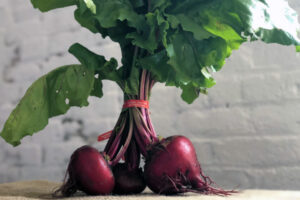 Roasted or raw, pickled or steamed, beets are a wonder of the root-vegetable world. Their color, texture, and taste (not to mention, their edible and delicious greens) allow for endless variation and experimentation. Like most vegetables, beets come in many different flavors and forms, all worthy of bringing home to your kitchen.
Roasted or raw, pickled or steamed, beets are a wonder of the root-vegetable world. Their color, texture, and taste (not to mention, their edible and delicious greens) allow for endless variation and experimentation. Like most vegetables, beets come in many different flavors and forms, all worthy of bringing home to your kitchen.
Storage: Separate greens from bulb immediately. Store greens and beets in separate bags. Eat the greens within two days. Eat the beets within a week.
Preparing: Beets can be eaten in a multitude of ways, all of which are delightful. Eat them raw by peeling and slicing or grating. They can be roasted in the oven, on the grill, on the stove-top, or even in the microwave.
Preserving: Pickling beets is a heavenly way to enjoy your beets for longer. If sour does not suit your fancy, freezing is also an option to extend the life of your beets. They should be cooked, peeled, and frozen in an airtight container. Beet greens should be blanched or wilted, drained, and stored in the freezer as well.
Crunchy, satisfying, and flavorful, peppers are always a crowd pleaser. Their myriad of colors also makes using them a treat. Peppers make both a great snack and base for a meal.
Storage: Keep in a bag in the refrigerator for a few days.
Preparing: Rinse, dry, then slice or chop. Fabulous raw (plain, scattered into salads, or with dips and soft cheeses) or roasted, grilled, sautéed, and stir-fried!
Preserving: To freeze, first roast and remove skin, then slice and store in freezer safe bags or containers. Pickle your peppers! Preserve them in olive oil!
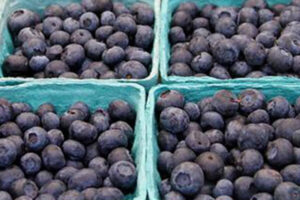 No matter how many handfuls you consume, it never seems to be enough. Blueberries are really spectacular at any time of the day, and if you need any further excuse for loving them, blueberries have health benefits as tremendous as their flavor.
No matter how many handfuls you consume, it never seems to be enough. Blueberries are really spectacular at any time of the day, and if you need any further excuse for loving them, blueberries have health benefits as tremendous as their flavor.
Storage: Blueberries will last for about a week if kept in a covered container or package. Only wash what you are about to use. If you see any blueberries starting to go bad remove them from the container.
Preparing: Rinse gently under cool water and pat dry. There are so many things that blueberries can improve but they are also fantastic plain. Eat them with breakfast in yogurt, cottage cheese, oatmeal, muffins, or pancakes. Blueberries can also brighten more savory dishes or toss them into a salad.
Preserving: The next best thing to fresh blueberries are frozen blueberries, which are great in smoothies! Wash and dry. Spread out and freeze on a flat baking sheet or tray. Once frozen, move to a bag and store. Jam is also a wonderful option and the particularly brave eaters can even pickle blueberries!
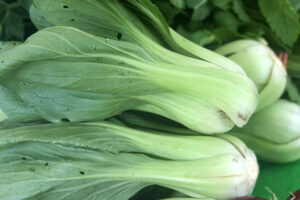 Although stir-fried bok choy is a kitchen classic, there are so many delicious ways to prepare this flavorful Asian green.
Although stir-fried bok choy is a kitchen classic, there are so many delicious ways to prepare this flavorful Asian green.
Storage: Keep in a bag in the crisper drawer in the refrigerator for a few days.
Preparing: Rinse and chop. Try bok choy raw in a salad or cook by roasting, braising, stir-frying, or grilling.
Preserving: Make bok choy kimchi, or bok choy chips!
Verdant and tree-like, broccoli holds its own in appearance and flavor. Both the stalks and tops are delicious and provide a combination of textures to dishes. Broccoli is low maintenance, easy to prepare, and tasty to eat.
Storage: Keep broccoli in a bag in the refrigerator for a few days.
Preparing: Rinse and dry broccoli. You can eat it raw with hummus or tzatziki, or try it in the dip itself! It is great in salads, on pizza, with quinoa, or grilled!
Preserving: Pickle the stems! Freeze!
Broccoli rabe, also referred to as Rapini, is brimming with health benefits and provides ample opportunities for creative cooking. Both the buds and heads of this vegetable are edible, as well as the stems. Although it has a bitter taste, when cooked with garlic and olive oil it makes a wonderful dish!
Storage: Keep in refrigerator crisper unwashed, wrapped in a bag or wet cloth/towel. This will keep your broccoli rabe fresh for 2-3 days.
Preparing: First, rinse under cold water. Trim the base of the stems and discard. Use a blanching technique instead of steaming to preserve crispiness and reduce bitterness. Rapini is also great sautéed.
Preserving: Blanch and freeze.
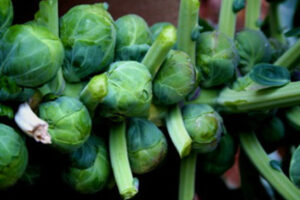 The round and ever-modifiable flavor of Brussels sprouts make them an all-star of winter’s harvest. With minimal preparation required, these exciting cruciferous vegetables lend themselves to dynamic, instant kitchen successes.
The round and ever-modifiable flavor of Brussels sprouts make them an all-star of winter’s harvest. With minimal preparation required, these exciting cruciferous vegetables lend themselves to dynamic, instant kitchen successes.
Storage: Keep sprouts in a closed container in the refrigerator for a few days. If the outer layers wilt slightly, don’t fret. Just peel them back to access the sprout.
Preparing: Remove from stalk, wash, and trim. Then sauté, roast, grill, or enjoy raw in a salad.
Preserving: Pickle them!
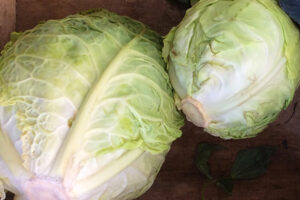 Cabbage is a versatile and delicious vegetable. Whether it is crunchy, cooked, or pickled, cabbage can be either part of a meal’s main event or one of the supporting sides. The core is also great for munching while cooking your meal. Napa Cabbage is a leafy veggie that can function in many of the same dishes as green cabbage, but has the added bonus of being delicious raw! You can use Napa cabbage for a wide array of culinary creations from salad to spring rolls and kimchi!
Cabbage is a versatile and delicious vegetable. Whether it is crunchy, cooked, or pickled, cabbage can be either part of a meal’s main event or one of the supporting sides. The core is also great for munching while cooking your meal. Napa Cabbage is a leafy veggie that can function in many of the same dishes as green cabbage, but has the added bonus of being delicious raw! You can use Napa cabbage for a wide array of culinary creations from salad to spring rolls and kimchi!
Storage: Store in a bag for a week or so. Wash and chop only before using, otherwise flavor will diminish.
Preparing: Cabbage is great raw in make-ahead slaws or salads, or cooked on the stovetop, grilled, or roasted. There are several varieties of cabbage and all have their own unique personalities and flavors.
Preserving: Pickled cabbage, like sauerkraut or kimchi, is a wonderful way to keep cabbage around for whenever you have a craving. Cleaned, blanched, drained, and chopped cabbage can also be frozen.
The beckoning scent of a ripe cantaloupe is almost as good as the pure flavor. Inside its hard shell is sweet melon waiting to be devoured with spoons.
Storage: Keep cantaloupe on the counter until ripe. You'll know when it is ripe when fragrant and when the spot where the stem/blossom was attached is soft when pressed. After being cut, cantaloupe will last for a few days in the refrigerator.
Preparing: Wash the outside of a cantaloupe well before cutting into it. Cantaloupe can and should be eaten freshly cut, but it is also delicious in soups, salads, sorbets, popsicles, and breads.
Preserving: Although fresh melons come and go in the blink of an eye, there are ways to stretch out their season. Try cantaloupe jam or conserve, or pickled cantaloupe.
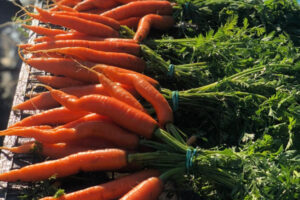 Crunchy and satisfying, carrots are so easy to eat raw. However, roasted carrots are well worth the extra step, and evidence of the myriad of flavors possible from such a seemingly ordinary vegetable.
Crunchy and satisfying, carrots are so easy to eat raw. However, roasted carrots are well worth the extra step, and evidence of the myriad of flavors possible from such a seemingly ordinary vegetable.
Storage: Remove tops (as tempting as the greens are, it is debatable whether they are safely edible, so unless the situation is dire, they probably do not make sense to eat). Store in the refrigerator for up to a week or longer in a bag. Wash immediately before use.
Preparing: Good raw: plain, dipped in hummus/pesto/guacamole/soft cheeses, grated into salads, etc. Also great grilled, roasted, or sautéed.
Preserving: Freeze carrots by washing, peeling, and blanching for a few minutes first. Then cut and store in freezer-safe containers. As with most vegetables, the briny route of pickling leads to happy munching as well!
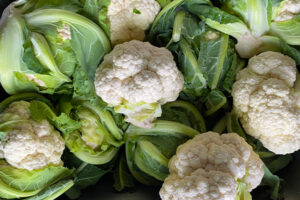 This snow white and wonderful vegetable is as delicious as it is healthy. Cauliflower is a versatile veggie. Enjoy it crunchy and raw or softer and cooked.
This snow white and wonderful vegetable is as delicious as it is healthy. Cauliflower is a versatile veggie. Enjoy it crunchy and raw or softer and cooked.
Storage: Keep in a bag in the crisper for a few days.
Preparing: Rinse and dry cauliflower. Cauliflower is delightful as a raw snack, plain or dipped in hummus or chopped into salads. You can cook cauliflower by roasting, grilling, sautéeing, stir-frying, steaming, or microwaving.
Preserving: Pickle or freeze!
Crunchy and satisfying, you cannot go wrong with celery. Its translucent sheen and spring hue make it as beautiful to look at as to eat. This perfect snack food is also superb when it is the meal’s centerpiece.
Storage: Keep wrapped tightly in the refrigerator in aluminum foil for up to a couple of weeks.
Preparing: Wash celery by peeling back stalks to rinse the inside and outsides. Dry. Chop off the leaves and use them like herbs (celery is a two-for-one, hooray!). Chop off the base. Eat stalks raw with peanut butter, hummus, tzatziki, salsa, guacamole, etc. Celery is also awesome chopped into salads. Try it grilled, roasted, sautéed, or stir-fried for a change of pace.
Preserving: Pickled celery is yummy!
Although celeriac’s name might not recommend itself to you, its flavor is sure to win you over. Beneath the peel is a pearly white and pristine vegetable waiting to be devoured.
Storage: Keep celeriac in a bag in the crisper for up to a few weeks after taking off stems and leaves.
Preparing: Rinse and peel. Celeriac is delicious raw in salads, roasted, grilled, sautéed, and mashed.
Preserving: Try pickling!
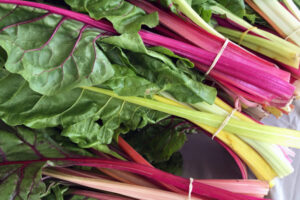 Chard (or Swiss Chard) is one of the prettiest dark, leafy greens with its white or rainbow stems. Its flavor is as unique as it is delicious and the stems area as tasty as the greens.
Chard (or Swiss Chard) is one of the prettiest dark, leafy greens with its white or rainbow stems. Its flavor is as unique as it is delicious and the stems area as tasty as the greens.
Storage: Chard should be kept in the refrigerator for up to a few days in a bag.
Preparing: Treat chard like kale or beet greens, or even try substituting it for either of those ingredients. Wash immediately before use and only as much as you plan on using. The stems and leaves are both wonderful, and if you are worried about the stems being crunchy cook them a little bit longer before adding the leaves to whatever dish you are making. If you find yourself using only the leaves, roast the stems. Chard can be used raw in salads, or it can be cooked in a skillet. It can also make for a hearty meal with garbanzo beans. Roasted or grilled is super easy and tasty too! You can always microwave your chard.
Preserving: Keep your chard around for longer by freezing it or pickling the stems!
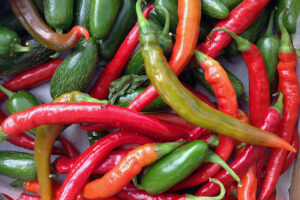 Spice up your life and your meals with chilies! High in Vitamin C, Potassium, and Magnesium, chillies are both nutritious and flavorful. The diversity in both appearance and flavor makes chili peppers a special addition to have in your kitchen.
Spice up your life and your meals with chilies! High in Vitamin C, Potassium, and Magnesium, chillies are both nutritious and flavorful. The diversity in both appearance and flavor makes chili peppers a special addition to have in your kitchen.
Storage: Keep chilis in a paper bag in the refrigerator.
Preparing: Add to any stir fry, soup or other dish to spice things up. Make chili oil or salsa.
Preserving: Try making chili infused olive oil! Or you can dry, freeze, or pickle your chili peppers!
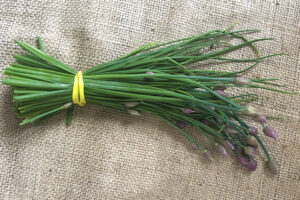 The herb version of leeks, onions, and garlic, chives have a distinct flavor and appearance that can make your cooking taste extra delicious. It is springy in flavor and appearance, and wonderful scattered in all of your food.
The herb version of leeks, onions, and garlic, chives have a distinct flavor and appearance that can make your cooking taste extra delicious. It is springy in flavor and appearance, and wonderful scattered in all of your food.
Storage: Either store in a bag in the refrigerator (try a damp cloth around them) or like flowers in a jar with water. See what works best for you!
Preparing: Rinse and dry. To make chopping easier try putting a rubber band around the middle. The delicate flavor of chives is wonderful in so many ways: sautéed, stir-fried, in pesto, tossed into salads, with eggs, in salsa, or on potatoes. Just remember: When using chives do not expose to heat for long or else their flavor will dissipate, so mix into warm dishes after removal from heat!
Preserving: Freeze or dry; or make chive oil or chive vinegar.
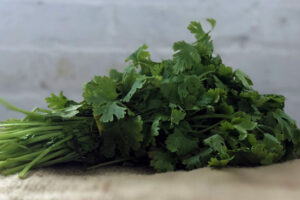 This delightful herb can make any dish inspired with a mere handful, allowing you to add creativity to your cooking Use cilantro to brighten salads, grains, pastas, and salsas…or even try it in pesto!
This delightful herb can make any dish inspired with a mere handful, allowing you to add creativity to your cooking Use cilantro to brighten salads, grains, pastas, and salsas…or even try it in pesto!
Storage: Keep cilantro in a glass jar of water covered in the refrigerator for several days.
Preparing: Rinse, dry, and chop. Try cilantro in salads, salsas, curry, soups, with barley, in pesto, and in bread.
Preserving: You can freeze cilantro, make cilantro oil, or pickle with it.
Another fabulous dark leafy green, collards are a hearty addition to any meal. Like most leafy greens, it can swap in for chard and kale most of the time and is a wonderful alternative for when you want to mix things up.
Storage: Store in bag for a few days in the refrigerator. If they are wilted, revive under cold water.
Preparing: Just like kale or chard, collards can be cooked in the microwave or a pan all by themselves. Impressive in their versatility, they are also great sautéed, roasted, braised, stir fried, included in a frittata, thrown into quesadillas (just fold them in with the cheese), and raw!
Preserving: You can freeze them.
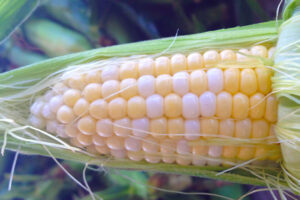 No denying one of the best parts of the summer is fresh corn. Its season is fleeting, but relish it while you can. Eat fresh corn as soon as possible to maximize its flavor!
No denying one of the best parts of the summer is fresh corn. Its season is fleeting, but relish it while you can. Eat fresh corn as soon as possible to maximize its flavor!
Storage: Eat corn immediately so you do not have to worry about storing it. Or refrigerate in the husk for as short a time as possible.
Preparing: Although you can eat it raw, boiled corn is a superb standby. Grilled corn is great too, but don’t stop there. Try corn on pizza, in salads, or even corn soup with roasted corn guacamole!
Preserving: If you can’t eat it but want to keep it, pickle your corn! Or freeze it.
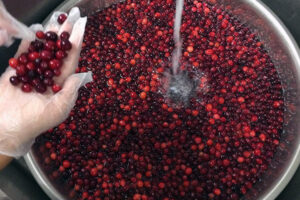 These tart little fruits are fantastic raw, dried, and cooked. Cranberries are a zesty and inspiring fall fruit that will perk up many of your sweet or savory dishes.
These tart little fruits are fantastic raw, dried, and cooked. Cranberries are a zesty and inspiring fall fruit that will perk up many of your sweet or savory dishes.
Storage: Keep in the refrigerator for several days if fresh. If dried, store in a closed container in the pantry for a few weeks.
Preparing: Cranberries are delicious in a multitude of ways. Try fresh cranberries raw in salsas or chutneys, or roast or bake with them! Try tossing dried cranberries into salads, oatmeal, granola, trail mix, and baked goods!
Preserving: Make some cranberry jam!
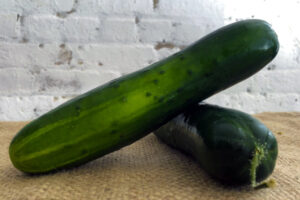 Refreshing, crunchy, sweet… cucumbers take the cake as a perfect summer vegetable. Although fantastic in recipes, cucumbers do not need to be tampered with because their flavor is near perfection by itself.
Refreshing, crunchy, sweet… cucumbers take the cake as a perfect summer vegetable. Although fantastic in recipes, cucumbers do not need to be tampered with because their flavor is near perfection by itself.
Storage: Keep in a bag in the refrigerator for several days, but be careful not to let them freeze.
Preparing: Wash and dry. Peeling is optional depending on your purpose or personal preference. Sliced and eaten plain or with dips, cucumbers make a wonderful appetizer, side, or snack. Cucumbers can also be the dip itself when used to make tzatziki or raita. Cucumbers can be chopped into salads or sliced and put on sandwiches. Cold cucumber soup is also a refreshing summer option.
Preserving: Pickles, pickles, pickles!
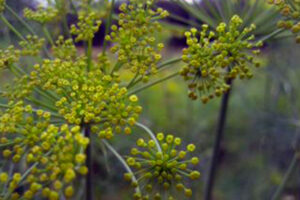 Dill has quite the distinctive flavor, instantly recognizable in pickles, salads, and sauces. It looks rather feathery, but it can have quite the powerful impact in your food. Although dill is available dried, stick to the fresh stuff if you can (or if all else fails, amp up the amount of dried dill you are using). Dill seeds are also available and withstand the heat of cooking better than the delicate dill leaves.
Dill has quite the distinctive flavor, instantly recognizable in pickles, salads, and sauces. It looks rather feathery, but it can have quite the powerful impact in your food. Although dill is available dried, stick to the fresh stuff if you can (or if all else fails, amp up the amount of dried dill you are using). Dill seeds are also available and withstand the heat of cooking better than the delicate dill leaves.
Storage: Keep fresh dill in the refrigerator wrapped in a damp cloth in a bag for a few days. It is rather fragile so use it sooner rather than later. Dill seeds should be stored in a pantry for up to a few months.
Preparing: Fresh dill should be washed. Both the stems and leaves are edible so if you like the crunch of the stems chop them up and them to the recipe too. If you do not care for the stems, remove the leaves and chop them up. Fresh dill is delicious in all sorts of forms but if you are using it in warm dishes only add it near the end, otherwise the flavor will diminish. Try fresh dill in soups, salads, sauces, and with eggs. Dill seed can be great raw or toasted (as with most spices a quick toast in a frying pan brings out a stronger flavor). Try dill seeds in soups, stews, biscuits, and salad dressings, or tossed into salads for a crunchy and flavorful addition.
Preserving: Pickles and dill are almost synonymous. Use dill seed or fresh dill to make dilly beans or any kind of pickles using cucumbers, carrots... really any veggie you want. Or you can make dill oil!
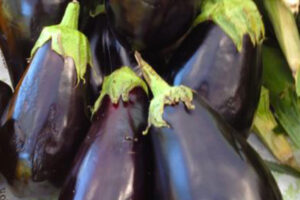 Hearty and comforting, eggplant is a substantive vegetable with a wonderful flavor. Its purple color adds to its unique appearance and there are as many shapes and sizes as there are uses for eggplant.
Hearty and comforting, eggplant is a substantive vegetable with a wonderful flavor. Its purple color adds to its unique appearance and there are as many shapes and sizes as there are uses for eggplant.
Storage: Eggplant can last for up to a few days, just remember the sooner you eat it the sweeter it is. The skin also tastes good (but will grow bitter along with the insides)! Keep in a bag in the refrigerator for up to a few days.
Preparing: There are so many great ways to prepare eggplant. For an appetizer or sandwich spread, baba ganoush is as delicious as it is easy. There are a million things you can do with grilled eggplant. Roasted and sautéed eggplant are both quite good too, and ratatouille is a favorite.
Preserving: If you don’t want your eggplant to go bitter and are having trouble eating it in time, freezing is always an option! You can also preserve it in olive oil.
The curly leaves of escarole embellish any salad. Light, crisp, and sharp when raw or mellow and sweeter when tamed with heat, this divine endive is always a pleasure to cook and eat.
Storage: Keep in a bag in the refrigerator for up to a few days.
Preparing: Rinse and dry as you would any other green. Enjoy escarole raw in salads, or cooked by braising, roasting, grilling, or sautéing.
Preserving: Make escarole soup and freeze it!
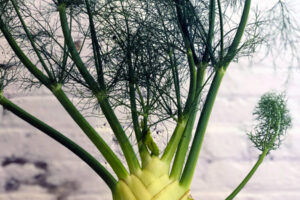 With edible fronds, stalks, and bulbs, fennel is a three for one. It infuses dishes with its anise flavor without overwhelming.
With edible fronds, stalks, and bulbs, fennel is a three for one. It infuses dishes with its anise flavor without overwhelming.
Storage: Remove fronds and store both fronds and bulbs in bags for up to a few days. Eat sooner rather than later for fresher flavor.
Preparing: The fronds, bulb, and stalk all need to be cleaned and cut. Raw or cooked, fennel is a flavorful and fun addition to your meal. You can eat and use the stalks like celery and the fronds are great chopped up as herbs. Try fennel raw in salads, roasted, grilled, sautéed, or on pizza!
Preserving: You can dry the stalks, pickle, or freeze fennel.
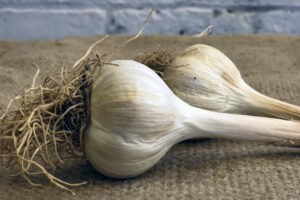 By maximizing the flavors of whatever it accompanies, garlic has the potential to make any dish tastier. Whether you eat the clove by itself (roasted and delicious) or sautéed with your greens, garlic is a game changer in the kitchen.
By maximizing the flavors of whatever it accompanies, garlic has the potential to make any dish tastier. Whether you eat the clove by itself (roasted and delicious) or sautéed with your greens, garlic is a game changer in the kitchen.
Storage: Keep fresh garlic either in the refrigerator in the crisper or hang it at room temperature to dry. Dried garlic will last for several months while fresh garlic will last for a few.
Preparing: Use garlic raw in salad dressings, sauté it, roast it, grill it, love it!
Preserving: Although garlic’s shelf life seems almost eternal, it is a great addition to pickles, or as a pickle!
 Harvested from garlic plants, garlic scapes are quite the treat. Almost sculptural, they look as beautiful as their name sounds and taste like a toned down version of garlic.
Harvested from garlic plants, garlic scapes are quite the treat. Almost sculptural, they look as beautiful as their name sounds and taste like a toned down version of garlic.
Storage: Although better to eat sooner, keep garlic scapes in a paper bag in the refrigerator for 2-4 weeks.
Preparing: Both the stalk and bud are edible raw or cooked. You can do even more with garlic scapes than you can with garlic. To give you a taste of the range of possibilities, start thinking about garlic scape dip, roasted scapes, and lots more!
Preserving: Freeze or pickle!
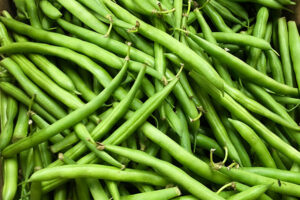 This elegant vegetable, with its edible pod and beans, is easy to cook and a delight to eat. The texture, flavor, and color of green beans make them either an exciting accent to many dishes or a standalone part of the meal.
This elegant vegetable, with its edible pod and beans, is easy to cook and a delight to eat. The texture, flavor, and color of green beans make them either an exciting accent to many dishes or a standalone part of the meal.
Storage: Eat greens as soon as possible, but if you must store them, refrigerate in a bag.
Preparing: Wash and dry beans and trim the ends. Green beans are extremely versatile. Simmer with caramelized onions, steam them solo, roast with a little butter, stir fry in a wok, or simply grill.
Preserving: To freeze green beans, start by blanching them for a couple of minutes. Then cool them in ice water, drain, dry, and put into bags or containers. Pickling green beans with dill is a great way to preserve them too, and they’re particularly fun because you can call them "dilly beans"!
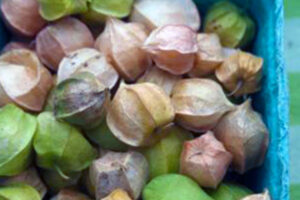 These addictive little treats, hidden beneath their husks, are a true gem of the summer harvest. Husk cherries (or "ground cherries") look like mini tomatillos but taste sweeter. Once you start popping them in your mouth you won’t be able to stop
These addictive little treats, hidden beneath their husks, are a true gem of the summer harvest. Husk cherries (or "ground cherries") look like mini tomatillos but taste sweeter. Once you start popping them in your mouth you won’t be able to stop
Storage: Keep them on the counter covered in their husks for up to a few weeks.
Preparing: Remove husk. Rinse, dry, and enjoy. Husk cherries are great on their own, but if you want to fuss with them it can be worthwhile as well. Try them on toast or in salads, pastries, and even salsa.
Preserving:Make compote, jam, or pickles!
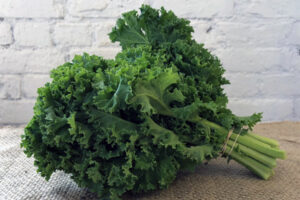 Although kale seems to be one of the more popular vegetables around these days, there is good reason for all the hype. Kale’s great flavor and versatility make for some adventuresome cooking. Its spicy flavor brightens any dish, but it also mellows out when cooked. Some varieties of kale:
Although kale seems to be one of the more popular vegetables around these days, there is good reason for all the hype. Kale’s great flavor and versatility make for some adventuresome cooking. Its spicy flavor brightens any dish, but it also mellows out when cooked. Some varieties of kale:
- Curly Kale - Classic kale with its signature strong peppery flavor. Wonderful when cooked or made into kale chips!
- Lacinato Kale - Also know as “dino kale” because its bumpy leaves resemble dinosaur skin. Lacinato is sweeter and earthier than curly kale and is a favorite in Italian cooking.
- Red Russian kale is both beautiful and delicious. It is more tender and slightly sweeter than curly kale. Its tenderness makes it delicious both when raw and after cooking!
Storage: Store in a bag in the refrigerator for up to about a week.
Preparing: Wash and dry kale, only right before use and as much as you plan on using. Kale is superb in all of its forms. Eating it raw — with a little olive oil, lemon, and parmesan — is so easy and satisfying. And sautéed on its own or with eggs is great too! Grilled and roasted kale are also delicious.
Preserving:To freeze kale, wash, blanch, drain, and store it in a sealed bag or container. Pickling is also an option.
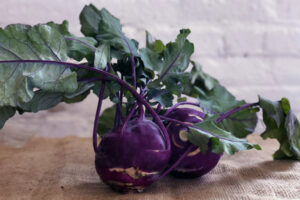 This vegetable, almost alien in appearance, is as versatile as it is delicious. Beneath its purple (or green) skin you can find a flavor somewhere between cabbage and turnips. The greens are edible, nutritious, and delicious too!
This vegetable, almost alien in appearance, is as versatile as it is delicious. Beneath its purple (or green) skin you can find a flavor somewhere between cabbage and turnips. The greens are edible, nutritious, and delicious too!
Storage: Keep kohlrabi in a bag in the refrigerator for a couple of weeks (although the consistency is better if eaten within a week). If the leaves are attached, remove them and store them in a bag.
Preparing: Kohlrabi is good both raw and cooked. Wash, cut ,and peel. Kohlrabi is delicious raw or chopped into salads. Try it roasted, grilled, and sautéed or try baked kohlrabi fries! Eat the greens too in salads, substituted for kale/collards/beet greens, or in pesto!
Preserving: Make pickles! Freeze kohlrabi raw or cooked!
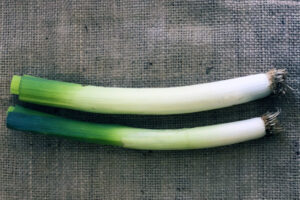 Though leeks are akin to garlic and onions, they are less overpowering. This mellow vegetable can hold its own, as it is both delicately sweet but firm in texture. They are in season both in the summer and winter, so they are equally enjoyable in a refreshing salad or in a hearty soup.
Though leeks are akin to garlic and onions, they are less overpowering. This mellow vegetable can hold its own, as it is both delicately sweet but firm in texture. They are in season both in the summer and winter, so they are equally enjoyable in a refreshing salad or in a hearty soup.
Storage: Store unwashed and untrimmed in a loose bag in the refrigerator. They will keep for one to two weeks.
Preparing: Make sure to wash your leeks well, as there is often a substantial amount of grainy soil concealed inside of a leek’s wrapper-like leaves (called sheaths). Chop off the little fringes at the bottom of the sheaths. The white and light green parts are the tender, edible meat of the vegetable, but the dark green parts make for a great stock, so don’t discard them just yet!
Preserving: Slice and store in bags in the freezer. Or, if you’re feeling a little more adventurous, why not make some leek jam to top on goat cheese crostini?
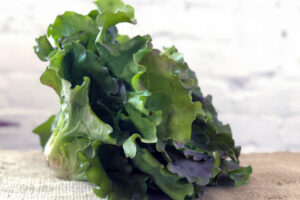 Fresh lettuce from a local farm does not need to be drowned in dressing to mask the tasteless leaves so often found in the supermarket. Although salad made with fresh lettuce is almost divine, do not confine yourself to salad! (Or if you do, make it an exciting salad.)
Fresh lettuce from a local farm does not need to be drowned in dressing to mask the tasteless leaves so often found in the supermarket. Although salad made with fresh lettuce is almost divine, do not confine yourself to salad! (Or if you do, make it an exciting salad.)
Storage: Salad should be stored dry in a bag for up to a few days in the refrigerator.
Preparing: Wash only immediately before use and only what you are planning on using. Dry as well as possible. Although lettuce is delicious raw, it can be really great grilled, stir-fried, or even roasted.
Preserving: If you think your lettuce is going to go bad before you have a chance to eat it, try pickling it!
The aroma of this delicate herb infuses its effervescent flavor into whatever surrounds. Marjoram will heighten the interest and intrigue of any dish, making dynamic and flavorful cooking as easy as the addition of this one ingredient.
Storage: Keep in a bag in the refrigerator for up to a few days.
Preparing: You can use marjoram instead of oregano. Try it in soups, salads and salad dressings, with eggs, with beans, or with roasted vegetables.
Preserving: Freeze and dry marjoram! Also try making herb oil or using it in pickles.
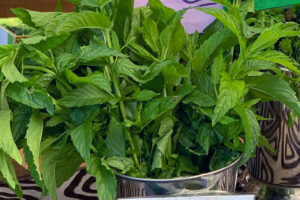 There’s simply nothing more refreshing than mint. This herb can work wonders on a hot summer day (and not just in homemade mint-chocolate-chip ice cream). Its role in a meal is clear: to make everything taste better.
There’s simply nothing more refreshing than mint. This herb can work wonders on a hot summer day (and not just in homemade mint-chocolate-chip ice cream). Its role in a meal is clear: to make everything taste better.
Storage: Clean, dry, and store in a bag for up to a week.
Preparing: Chopped mint is good in many, many dishes. Not just a garnish, it brings the body of a meal to life. Try it in a minty summer salad with asparagus and fava beans, or have it on bruschetta, in a chutney, or with lentils.
Preserving: Try drying or freezing mint.
If you’ve never had mizuna greens before, then you are in for a treat. This spicy Japanese green will tickle your tastebuds and add some oomph to your salads! Use it as you would arugula or mustard greens.
Storage: Store like other lettuce leaves, in a bag for up to a few days. If it looks wilted, revive by running under cold water.
Preparing: There is so much to do with mizuna because it does so much for the flavor of your dishes. Mizuna is great thrown into sandwiches or salads, but you can alsi try it raw, sautéed, steamed, or on bruschetta!
Preserving: You can pickle mizuna!
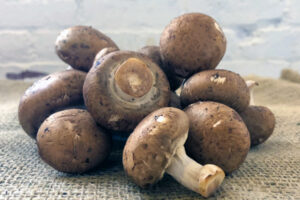 There are so many delightful varieties of mushrooms, including:
There are so many delightful varieties of mushrooms, including:
- Oyster Mushrooms - Vibrant oyster mushrooms come in all sorts of colors and sizes. You can prepare them traditionally or be bold and daring in the kitchen with them. Either way, their easily enjoyed flavor will make eating them one of your favorite activities.
- Shiitake Mushrooms - These fantastical fungi have an earthy flavor and will add an inspired texture and taste to many dishes. Shiitake mushrooms are also incredibly easy to dress up or down, making for a fast dinner or featured as the highlight of an elaborate spread.
Storage: Refrigerate for up to a few days, but not in plastic. To maximize freshness, try keeping them in a paper bag or in damp cloths in the refrigerator, but eat sooner rather than later.
Preparing: If dried, rehydrate; if fresh, just rinse them. Remove the stems (and use those in soup), and enjoy sautéed, roasted, grilled, or in a stir fry.
Preserving: Try marinating them in oil, or pickle them!
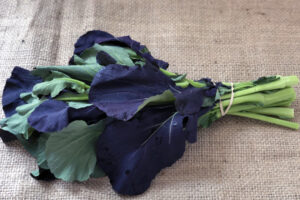 For those of you who find greens boring, be prepared to eat your words (literally!) with these spicy and exciting leaves. You can tone them down by cooking them or leave them raw. Mustard greens can perk up any salad or dish and are great either as the centerpiece or side.
For those of you who find greens boring, be prepared to eat your words (literally!) with these spicy and exciting leaves. You can tone them down by cooking them or leave them raw. Mustard greens can perk up any salad or dish and are great either as the centerpiece or side.
Storage: Keep like other lettuces in a bag in the refrigerator for up to a few days.
Preparing: Wash and dry. Try them in salads, sautéed, in pesto, on pizza, with Indian spices, or in frittatas. Feel free to substitute them for other greens and see the exciting flavor combinations that result.
Preserving: Pickle them!
While the edible flowers of nasturtium plants are delightful in their own right, the sensational leaves of nasturtiums will produce a devoted following in their wake. These spicy leaves will awaken any salad and reproduce the energy accompanying springtime on your plate. Don’t miss the leaves for the flowers!
Storage: Keep in a bag in the refrigerator for up to a few days.
Preparing: Like many other spicy greens (think arugula), there are innumerable ways to enjoy nasturtium greens. Gently rinse and dry them, and after that your options are nearly limitless. Substitute other spicy greens with nasturtium greens (think dandelion greens, mustard greens, and arugula) in all sorts of dishes or just toss them into salads and pesto for some extra heat! Nasturtium greens are infinitely variable and always exciting.
Preserving: Although the leaves will freeze similarly to other greens (blanch, drain, and freeze), if you happen to find yourself with nasturtium pods, you can pickle them and use them like capers! You can also try making nasturtium vinegar!
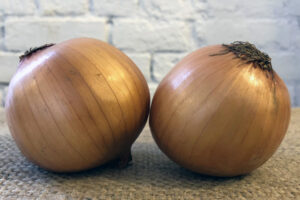 Although chopping them might require goggles (just wear clear ones you would wear in the pool)!, onions are an essential part of anyone’s pantry. Either sharp when raw or sweet if caramelized, onions can be anything you want them to be.
Although chopping them might require goggles (just wear clear ones you would wear in the pool)!, onions are an essential part of anyone’s pantry. Either sharp when raw or sweet if caramelized, onions can be anything you want them to be.
Storage: Onions, depending on whether they are cured or not. An uncured onion will last up to a couple of months, while a cured one will last for almost a year. Keep onions in a cool, dark place away from potatoes.
Preparing: Wash and peel. Slice onions (and wipe away any tears). Raw onions have a bite that can be tempered by soaking. They are great in salads and on sandwiches. Onions can be cooked in a variety of ways and become very sweet and juicy: roasted, caramelized, and grilled.
Preserving: You can freeze chopped onions for cooking later. You can also pickle onions and use them in salads and on sandwiches!
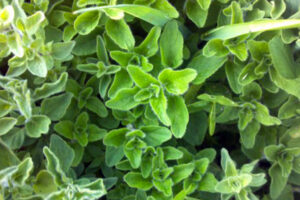 These little leaves are packed with flavor and can be used in a wide array of sauces, salads, and dishes. The appealing smell, taste, and appearance will spruce up even the simplest of dinners.
These little leaves are packed with flavor and can be used in a wide array of sauces, salads, and dishes. The appealing smell, taste, and appearance will spruce up even the simplest of dinners.
Storage: Store wrapped in a damp towel in a drawer in the refrigerator for up to a week.
Preparing: Rinse and dry. Remove leaves and chop. Oregano can be used on pizza, in salad, tossed with roasted vegetables, in pesto, with eggs, in almost anything you can imagine… including ice cream!
Preserving: Oregano oil is an awesome sauce, and dried oregano is good to have on hand. Oregano also makes for a more interesting pickled pepper.
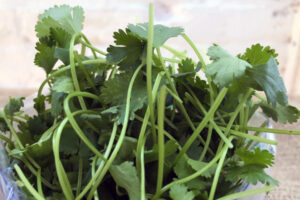 Parsley is a wonderful herb that can work miracles on food. Herbs in general can make any meal worth remembering and parsley is no exception to that rule. There are different kinds of parsley, all of which are worth using.
Parsley is a wonderful herb that can work miracles on food. Herbs in general can make any meal worth remembering and parsley is no exception to that rule. There are different kinds of parsley, all of which are worth using.
Storage: To have parsley last for longer than a week, remove the leaves and keep sealed in the refrigerator.
Preparing: Clean leaves and chop to add to any recipe or garnish any dish. Even if a recipe does not call for an herb, sample a spoonful of the dish with some chopped parsley on top. If it tastes good together, then add the parsley!
Preserving: Parsley can be washed, chopped, and frozen. Parsley oil is also a great way to have the flavor linger!
Parsnips are a perfect food for any dish in any season. These delightful roots are rather sweet and earthy, making a wonderful base for many meals. With just a little cooking parsnips go a long way and are very versatile.
Storage: Keep in a bag in the crisper in the refrigerator for up to a couple of weeks. Remove any greens and throw them away — they are not edible!
Preparing: Parsnips are bound to taste good no matter what you do to them. Try roasting them, sautéing them, or boiling and puréeing them, or putting them in pesto!
Preserving: Make pickles!
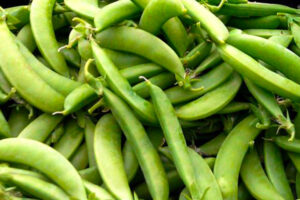 A single pod, several small spherical peas, vitamins and calciums. You cannot lose with peas. Let this crop become popular in your home!
A single pod, several small spherical peas, vitamins and calciums. You cannot lose with peas. Let this crop become popular in your home!
Storage: As soon as peas are picked they start to lose their sweetness. If you cannot use them right away, try freezing your peas.
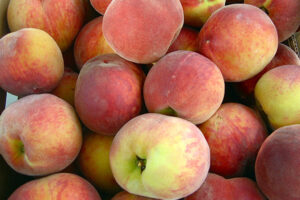 The flavor, texture, color, and scent of a fresh, ripe peach has no equal in its perfection. Enjoy them while they last. Although peach season is shorter than you might like, it still can be quite abundant and perfect for Pick Your Own opportunities in Rhode Island.
The flavor, texture, color, and scent of a fresh, ripe peach has no equal in its perfection. Enjoy them while they last. Although peach season is shorter than you might like, it still can be quite abundant and perfect for Pick Your Own opportunities in Rhode Island.
Storage: To ripen, keep peaches in a brown bag on the counter until just soft. Once they are ripe, eat them or keep them in the refrigerator to stop the ripening process.
Preparing: Rinse and enjoy (just don’t eat the pit). Nothing rivals a peach by itself, but you can put them in sauces, salads, salsas, breads, muffins, cookies, cobblers, pies, and sorbet.
Preserving: Go crazy! Make peach season last all year by making peach jam, peach preserves, canned peaches, pickled peaches, or just freeze them.
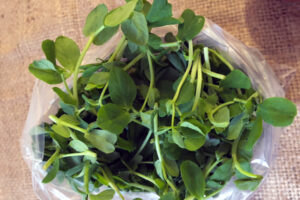 Evocative of spring time, pea greens are a light, delicate salad green. Although they are the shoots from pea plants, pea greens deserve their own limelight.
Evocative of spring time, pea greens are a light, delicate salad green. Although they are the shoots from pea plants, pea greens deserve their own limelight.
Storage: Keep in the refrigerator in a bag. Eat sooner rather than later because they taste best when fresh.
Preparing: Rinse and dry. Pea greens are wonderful in salads, sautéed, stir-fried, in quesadillas, or on eggs.
Preserving: Be adventurous and try pickling them!
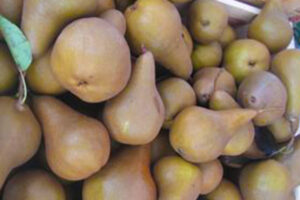 With a crisp, refreshing, and sweet taste, pears are a great snack, complement to a meal, or base of a dessert. Pears have beautiful speckled skin and a great soft texture that make them unique.
With a crisp, refreshing, and sweet taste, pears are a great snack, complement to a meal, or base of a dessert. Pears have beautiful speckled skin and a great soft texture that make them unique.
Storage: Pears should be stored at room temperature. You will know a pear is ripe because it will give slightly when gently pressed and smell wonderfully aromatic. The stem will also have a little give when it’s jiggled slightly.
Preparing: You can eat pears raw, bake them into muffins, make a pear crisp, or a pear upside-down cake... Pears are also great poached.
Preserving: Try making a compote, can them, or make pear butter!
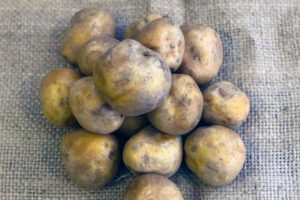 Hearty, comforting, and filling, potatoes are a staple. So simple to prepare and so easy to make in so many ways, potatoes can be a core ingredient in building an array of dishes.
Hearty, comforting, and filling, potatoes are a staple. So simple to prepare and so easy to make in so many ways, potatoes can be a core ingredient in building an array of dishes.
Storage: Keep away from onions in a cool, dry, dark place. Make sure they are dry and check them often.
Preparing: Do not eat raw. Potatoes are fantastic baked, boiled, smashed, in curry, in soup or stew, in salads, grilled, roasted, and sautéed.
Preserving: Since potatoes last so long, unless you find yourself with a glut of potatoes, you should not have to worry about other preservation methods.
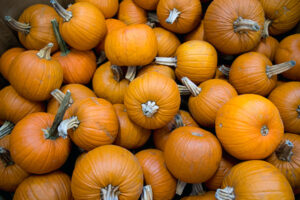 The hallmark of Halloween and a common flavor of Thanksgiving, pumpkins are sure to be celebrated. Don’t let their hard exterior keep your from trying out all kinds of fantastic pumpkin dinners and desserts.
The hallmark of Halloween and a common flavor of Thanksgiving, pumpkins are sure to be celebrated. Don’t let their hard exterior keep your from trying out all kinds of fantastic pumpkin dinners and desserts.
Storage: Keep at room temperature for up to a few weeks in a pantry or longer in the refrigerator.
Preparing: Pumpkins are delicious roasted, grilled, and puréed. Don’t forget to roast the seeds for a tasty, crunchy snack!
Preserving: Make pumpkin butter ,or if you are feeling adventurous, try some pickled pumpkin! You can always freeze your cut/prepped pumpkin for future meals.
Purslane, although often dubbed a weed, deserves an alternate reputation as an object of edible admiration. Its pleasant flavor, springy hue, and delightful name prove that one gardener’s trash is another cook’s treasure.
Storage: Use purslane as soon as possible to maximize fresh flavor. Store in the crisper for a couple of days if necessary in a bag.
Preparing: Like many other greens, purslane is great in a variety of ways. Although the stems are edible, most people enjoy the leaves and tops. You can eat it raw or cooked — just rinse, dry, and enjoy.
Preserving: Pickle purslane.
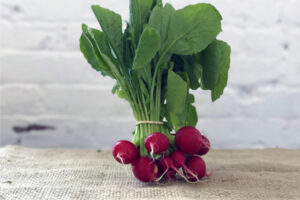 As pretty as they come, radishes are sweet to look at and spicy to taste. They are a powerful addition to a dish, transforming basics like bread and butter into picnic staples. Like beets, there are plenty of varieties from which to choose. The greens are an added bonus. Although slightly bitter by themselves, with company radish tops are a meal on their own.
As pretty as they come, radishes are sweet to look at and spicy to taste. They are a powerful addition to a dish, transforming basics like bread and butter into picnic staples. Like beets, there are plenty of varieties from which to choose. The greens are an added bonus. Although slightly bitter by themselves, with company radish tops are a meal on their own.
Storage: Like beets, remove tops and store bulbs and tops separately in bags in the refrigerator. Eat the tops within two days. The radishes last for a few days.
Preparing: Raw, roasted, sautéed, and grilled, radishes run the gamut in terms of their flexibility and willingness to be delicious at any given moment.
Preserving: Who doesn’t love a pickled radish? And if you don’t, freezing for the radishes and their greens will also suffice.
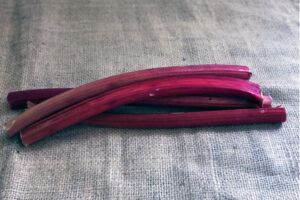 This vibrant vegetable often disguises itself as a fruit by frequenting summer deserts. With the ability to lean toward both the sweet and savory ends of the flavor spectrum, rhubarb lends itself to endless variation for any meal of the day. Just make sure you only eat the stalk because the leaves are inedible.
This vibrant vegetable often disguises itself as a fruit by frequenting summer deserts. With the ability to lean toward both the sweet and savory ends of the flavor spectrum, rhubarb lends itself to endless variation for any meal of the day. Just make sure you only eat the stalk because the leaves are inedible.
Storage: Store stalks whole in a bag in the refrigerator for several days. Revive rhubarb if necessary by soaking in water before using.
Preparing: Remove leaves (they are poisonous) and rinse your rhubarb. Raw or cooked, rhubarb can be prepared in both sweet and savory dishes. Try putting it in soups, salads, pies, and oatmeal.
Preserving: Freeze, dry, and can your rhubarb. Also, try rhubarb pickles!
Eaters owe much of their dining pleasure to this fragrant and fantastic herb. Rosemary infuses but does not overpower whatever it accompanies, making it a perfect dinner companion.
Storage: To keep fresh rosemary from becoming dry and brittle, rinse it (do not dry) and wrap in a paper towel and store in a bag for up to a few days.
Preparing: Try rosemary in soups and salads, with roasted or sautéed vegetables, or in pasta or grain salads. Make skewers out of the stems for grilling!
Preserving: Dry your rosemary or make rosemary infused olive oil.
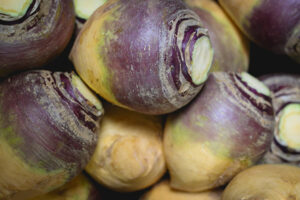 Everything about a rutabaga is pleasant including its wonderful name, satisfying flavor, and ease of preparation. Make hearty dishes or springy salads with it. Whatever you choose, the rutabaga will make for an amazing meal.
Everything about a rutabaga is pleasant including its wonderful name, satisfying flavor, and ease of preparation. Make hearty dishes or springy salads with it. Whatever you choose, the rutabaga will make for an amazing meal.
Storage: Keep in a bag in the crisper of the refrigerator for up to a couple of weeks.
Preparing: Eat rutabaga raw chopped, grated, or sliced into salads or try it roasted, mashed, or sautéed.
Preserving: Make rutabaga chips or rutabaga pickles!
Both understated and powerful, sage can transform your food from ordinary to extraordinary. Not confined to the traditional binary of sweet and savory, sage can expand your palette and your appetite.
Storage: Store in a bag in the refrigerator for up to a few days.
Preparing: Cook and bake with this magical herb. Finely chop sage into salads, roast vegetables with it, make sage tea, enjoy sage with pasta, or try eggs in sage butter.
Preserving: You can dry your own sage to intensify its flavor! Or easily make sage olive oil!
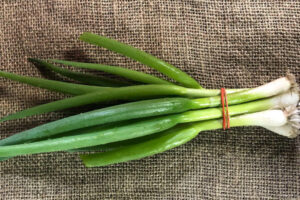 More demure than an onion, scallions can perk up almost any savory dish. Otherwise known as a green onion, the delicate flavor subtly reminds skeptics that onions can be remarkable.
More demure than an onion, scallions can perk up almost any savory dish. Otherwise known as a green onion, the delicate flavor subtly reminds skeptics that onions can be remarkable.
Storage: Store in a bag for up to a few days, however the green tops should be eaten as soon as possible. Do not wash until use. If you have scallions with roots, store them in a vase like flowers, with just enough water to just cover the roots and some access to sunlight. Then just snip the green tops to use as needed (the rest of the scallion will continue to grow.
Preparing: Snip root and enjoy the entire scallion in a variety of fashions. Or snip off just the greens and use more like chives. Scallions are superb raw in salads, with grains, or as a garnish. Scallions can also be sautéed with olive oil, baked into breads, roasted, and grilled.
Preserving: Wash, chop, and freeze raw in an airtight container. Remaining scallions also make happy pickles.
Savory is an herb with a long history and large place in lore. Introduced to northern Europe by the Romans. In fact, the herb is so famous it has become synonymous with a whole category of food! Its peppery flavor is used for many different dishes, although traditionally used to spice beans and other slow-cooked meats and vegetables. Its tender leaves can also be added to fresh salad to give it more flavor. If you are making a savory dish consider adding some savory!
Storage: Keep dry in an airtight container away from sunlight.
Preparing: As an herb, savory is used to add unique flavor to other vegetables and countless different dishes. Something to try is boiling savory alongside broccoli or sauerkraut. This technique also helps to eliminate strong cooking odors. You can also try steeping this herb in vinegar or salad dressing to create a nice aromatic flavor. The simplest use involves throwing some savory atop a salad, adding a zesty, citrus taste to your meal.
Preserving: Savory will not spoil, however over time will lose potency. Keep it stored in a dark, cool place. After some time, to test the herb's potency and effectiveness, crush or rub a small amount in your hand and check for strength of its aroma. The stronger the smell, the better the taste!
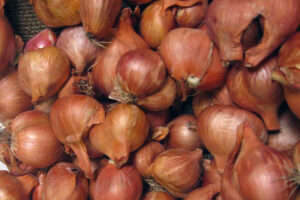 A sister to the onion, shallots are shaped more like a garlic. Shallots are sweet and mild, and are delicious additions to salad dressings, soups, and stir-fries.
A sister to the onion, shallots are shaped more like a garlic. Shallots are sweet and mild, and are delicious additions to salad dressings, soups, and stir-fries.
Storage: Store your shallots in the refrigerator for up to 2 weeks or in a well-ventilated place away from sunlight for up to a month.
Preserving: If you cannot go through your shallots quickly enough, try freezing them.
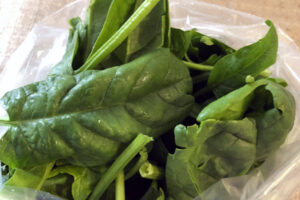 This dark and leafy green has a delicious flavor and infinite uses.
This dark and leafy green has a delicious flavor and infinite uses.
Storage: Keep in a bag in the refrigerator for up to a few days.
Preparing: Spinach is as good raw as it is cooked, and there are many ways to prepare it. Try it in salads, soups, creamed, microwaved, roasted, sautéed, and wilted.
Preserving: Make spinach chips! Or, just freeze it.
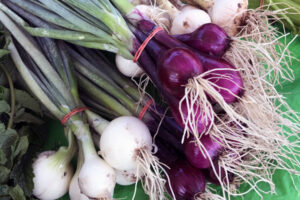 Bulkier and more robust in flavor than scallions, these early onions can transform your food from boring to brilliant. The greens on these onions are an added bonus and make using spring onions double the fun.
Bulkier and more robust in flavor than scallions, these early onions can transform your food from boring to brilliant. The greens on these onions are an added bonus and make using spring onions double the fun.
Storage: Store in a bag in the refrigerator for up to a few days. Like scallions, use the greens first because they only last up to a couple of days once refrigerated.
Preparing: Treat similarly to scallions, but expect a stronger flavor. Clean and cut off the bottom root. Sautéed, roasted, grilled, or raw are all fabulous options for eating spring onions — it just depends on what kind of onion flavor you are seeking.
Preserving: Although pickling and freezing (like scallions: clean, chop, and freeze) are always options, try preserving your spring onions in some olive oil for a temporary tasty measure.
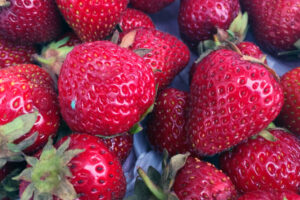 There are few foods that scream summer so much as strawberries. These berries are simultaneously light and hearty with so much versatility. Make sure to make the most of them as long as they are in season.
There are few foods that scream summer so much as strawberries. These berries are simultaneously light and hearty with so much versatility. Make sure to make the most of them as long as they are in season.
Storage: Do not wash until ready to use. Eat within a couple of days. Store in an airtight container with a paper towel between each layer to absorb moisture.
Preparing: Remove stems and either eat whole or slice to desired size. Strawberries can be eaten plain, or dipped in whipped cream or granulated sugar (but fresh and in season they are sweet enough on their own!) Strawberries are also delicious tossed into salads, cooked on the stovetop, roasted, grilled, and put into baked goods.
Preserving: Freeze, dry, and preserve by making strawberry jam. Also make pickled strawberries!
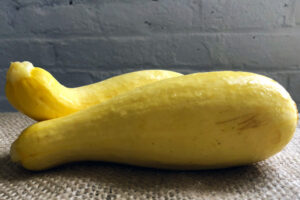 Summer squash and zucchini are staples of summer. They are substantial additions to any meal, but their flavor does not overwhelm. Their vibrant greens and sunny yellows make eating them all the more pleasant.
Summer squash and zucchini are staples of summer. They are substantial additions to any meal, but their flavor does not overwhelm. Their vibrant greens and sunny yellows make eating them all the more pleasant.
Storage: Store in a bag in the refrigerator. Eat within a few days, the squash sooner than zucchini. Everything, including the skin and seeds, is edible and there are a zillion things you can make!
Preparing: Wash and dry. Raw or cooked, you can chop, slice, grate, or make “pasta” with squash. They can also be sautéed, roasted, and grilled for marvelous results. For something crunchy, try dehydrating summer squash into chips!
Preserving: To freeze, first wash and blanch for a few minutes. Then chop, drain and seal in an airtight container. Pickling also does the trick!
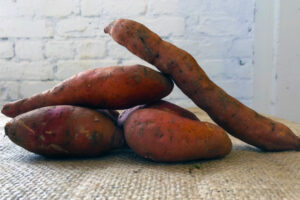 Sweet potatoes are tubers with a mildly sweet and pleasing flavor. They are also packed with nutrients. Malleable to almost any dish, sweet potatoes can be prepared sweet or savory, crunchy or soft. Don’t forget to eat the skin… it tastes delicious and is great for you too!
Sweet potatoes are tubers with a mildly sweet and pleasing flavor. They are also packed with nutrients. Malleable to almost any dish, sweet potatoes can be prepared sweet or savory, crunchy or soft. Don’t forget to eat the skin… it tastes delicious and is great for you too!
Storage: Store sweet potatoes in the cool, dark place away from onions for many weeks.
Preparing: Scrub the potatoes under running water and dry. Sweet potatoes can be roasted, boiled, mashed, puréed, grilled, and microwaved.
Preserving: Freeze your sweet potatoes!
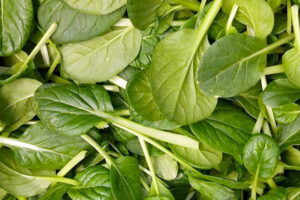 A brightly flavored alternative to spinach, tatsoi puts a delicious spin on traditional fare. The hint of mustard in this Asian green makes tatsoi the star of your salad.
A brightly flavored alternative to spinach, tatsoi puts a delicious spin on traditional fare. The hint of mustard in this Asian green makes tatsoi the star of your salad.
Storage: Store in a bag in the refrigerator for up to a few days.
Preparing: In addition to all of the possibilities for substituting tatsoi in for spinach, there are a multitude of tatsoi-specific recipes. Try it in salads, grilled, or sautéed.
Preserving: Try pickled tatsoi!
This herb has its own distinct flavor that provides a dish with an additional dimension and contributes to the depth in flavor you strive for in the kitchen. Thyme’s delicate little leaves are unobtrusive in stature and in taste, making them handy to keep on hand.
Storage: Wrap fresh thyme a damp paper towel in a bag and refrigerate for several days.
Preparing: Separate the leaves from the stem. Use the leaves in a whole range of dishes, from pasta to muffins to soup, and use the leaves and stems in soup stocks and when you braise (just remove them before you serve).
Preserving: To use up your thyme a little more slowly, try making thyme-infused olive oil, freezing it, or drying it.
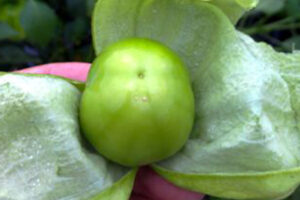 Not to be confused with a green tomato, these green and zesty fruits of summer are a great way to add new flavor to your cooking. Commonly used in Mexican cuisine (e.g., salsa verde), tomatillos are a refreshing treat.
Not to be confused with a green tomato, these green and zesty fruits of summer are a great way to add new flavor to your cooking. Commonly used in Mexican cuisine (e.g., salsa verde), tomatillos are a refreshing treat.
Storage: Keep in their husks in the refrigerator for up to a couple of weeks.
Preparing: Remove husks and rinse off. Tomatillos can be served raw or cooked. Often used to make tomatillo salsa, there are also several other ways to use them. Try them grilled, raw in salads, roasted, or stewed!
Preserving: Freeze your tomatillos whole or make salsa and can it.
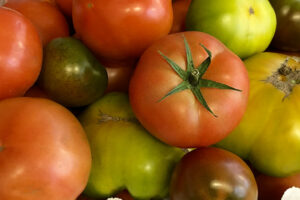 A summer delicacy with many varieties, shapes, sizes, and colors — enjoy tomatoes plain... or just eat them with everything.
A summer delicacy with many varieties, shapes, sizes, and colors — enjoy tomatoes plain... or just eat them with everything.
Storage: Keep on the counter in a cooler place for a few days, but not in the refrigerator!
Preparing: Whether tomatoes are eaten sliced with a sprinkle of sea salt, in a classic salad with fresh mozzarella, or enjoyed on toast with goat cheese, there is nothing like a fresh local tomato. Also try them roasted, sautéed, grilled, and stir-fried!
Preserving: Freeze! Make tomato paste! Dry them! Or pickle them!
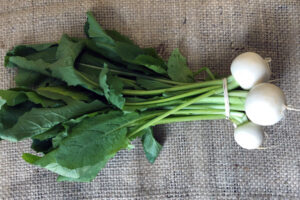 Whether they add some crunch to your salad or you roast them until tender, you will be glad they turned up in your kitchen. Hakurei and Scarlett Queen varieties of turnips are generally considered "salad turnips" because they are particularly delicious raw!
Whether they add some crunch to your salad or you roast them until tender, you will be glad they turned up in your kitchen. Hakurei and Scarlett Queen varieties of turnips are generally considered "salad turnips" because they are particularly delicious raw!
Storage: Remove greens (which are delicious!) and store them separately in a bag. Wash greens only immediately before use and use within a couple of days. Store turnips in another bag in the crisper for several days.
Preparing: You can enjoy turnips and their greens together in a salad, with grains like farro. You can also enjoy them on their own, raw or cooked. For the greens, use them as a salad green or sauté them like beet greens. For the turnips, eat them raw (chopped or grated) in salads, roasted, sautéed, or grilled.
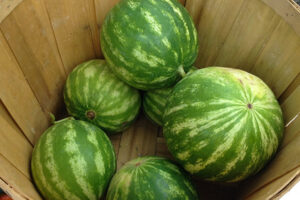 Juicy, crunchy, sweet, and satisfying &mdsh; watermelon is an annual highlight of summer’s harvest. Big or small, yellow or pink, this melon is delicious in all shapes and sizes. Eat as much as you can while it lasts.
Juicy, crunchy, sweet, and satisfying &mdsh; watermelon is an annual highlight of summer’s harvest. Big or small, yellow or pink, this melon is delicious in all shapes and sizes. Eat as much as you can while it lasts.
Storage: Keep on the counter in a cool place until ripe. You can tell a watermelon is ripe when you knock on it and it sounds hollow. Keep leftover sliced watermelon in a closed container in the refrigerator for a few days.
Preparing: Refrigerate watermelon either whole or chopped to improve the eating experience. Rinse the outside of your watermelon prior to cutting and slice. Watermelon is great raw, in salads, as popsicles, grilled... or try roasting the seeds!
Preserving: Don’t waste the rind, pickle it! To save extra cut watermelon you can freeze it!
Get to know the Winter Squash family:
- Acorn Squash - Even the name of this quintessential fall food sounds cozy. Sweet, hearty, and comforting, there are endless ways to make a satisfying meal entirely out of an acorn squash. Roasted, grilled, or sautéed... all are delicious ways to enjoy acorn squash. Don’t forget you can roast and eat the seeds.
- Butternut Squash - The poster child for the wonders of winter squash, butternut’s fame is well deserved. Its versatility, rich flavor and lovely color make for a beautiful and bountiful meal. The enormous health benefits of butternut squash also make it wonderful addition to your table. Cutting butternut squash may seem daunting but once you’ve learned the method it’s simple as can be. Roasted, grilled, microwaved, sautéed, or pureed, butternut squash is absolutely wonderful.
- Carnival Squash - Nothing says party like the brightly colored stripes and speckles on this happening squash. With its lively appearance and flavor, and the myriad ways to prepare it, carnival squash is sure to brighten up any of winter’s gray days. Rinse, dry, and cut. Then roast, bake, or braise to enjoy.
- Delicata Squash - This quirky, colorful squash has the personality to match its appearance and a delightful flavor to match its delicate and delectable name. Although a fall and winter squash, delicatas don’t hide under a hard shell, so once you’ve roasted the squash you can enjoy the skin along with it! Try it grilled, sautéed, steamed, microwaved, and mashed too! Also roast and eat the seeds like pumpkin seeds.
- Kabocha Squash - This cute winter squash is as delightful to eat as it is to look at. Smooth and silky, rich and earthy, it won’t cause you any kitchen conundrums. It also is very low maintenance, meaning dinner will be ready in minutes. Rinse and cut this squash. Don’t eat the skin but enjoy every other part of it by roasting the squash, roasting the seeds, sautéing it, braising it, or puréeing it!
- Spaghetti Squash - Although it looks like your average squash on the outside, spaghetti squash has a world of wonder to reveal in its center. Cooking produces long, noodle-like pieces of squash. Its unique appearance and delicious flavor make for exciting and diverse “pasta” dishes. Cook your spaghetti squash by roasting, boiling, grilling, or microwaving.
- Yugoslavian Finger Squash - This star-shaped squash can function as either a summer or winter squash depending on when it was picked. It has a very mellow flavor that makes its uses variable and it can be dressed up or cooked simply for however you feel like eating. You can roast this squash as you would any other winter squash by cutting off the top, scooping out the seeds, and baking it in the oven at about 350 degrees. It can also be cooked on the stovetop or in the variety of ways you cook your other winter squash. It is related to acorn squash, so you can treat it similarly and substitute in other winter squash recipes. You can also bake with it and use it in soup.
Storage: Keep all winter squash in your pantry or a dark, cool place for a couple of weeks.
Preserving: Freeze your winter squash.
While yu choy is related to bok choy and broccoli, it has a thinner stalk and yellow flowers. Used by many tossed in a stir-fry or a salad, it's also delicious sautéed with garlic and onions.
Storage: Store unwashed in the refrigerator crisper for up to three days.
Preparing: Remove any leaves that are yellow, have holes or any sort of imperfection, and cut about 1/4-inch off the stems. Then soak yu choy in 6:1 water to vinegar solution for 15 minutes, rub out any sand with your hands, and rinse several times in cold water. It is also very tasty when steamed!
Preserving: Chop up yu choy and put in freezer bags, squeeze as much air out as possible. Freeze to avoid becoming soggy or mushy.

10 Sims Ave, unit 103
Providence, RI 02909
401-312-4250
farmtoschool@farmfreshri.org
VOLUNTEER
Help facilitate child and family workshops at our outdoor farmers markets! Summer and fall opportunities available, beginning in July. Spanish language skills preferred, but not required. LEARN MORE →
RECENT NEWS
Own a Piece of RI State House History
Update Monday, June 12: Thank you for the outpouring of interest in this historic marble, and for all the support for Farm Fresh RI! We are completely sold out of all small pieces of marble. … Read More →
